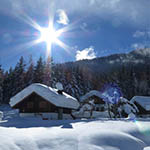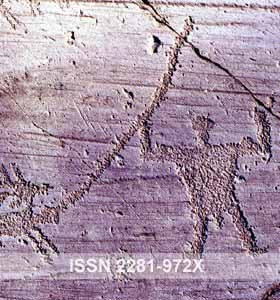 Il territorio di Crodo è situato in quella lingua delle Alpi Piemontesi che s’incunea tra la Svizzera tedesca e quella italiana. È ricchissimo di risorse naturali e culturali. La scoperta della Balma dei Cervi è per Crodo un ulteriore elemento di ricchezza: a tutti i visitatori il mio caloroso benvenuto nel nostro territorio e nel nostro Museo Virtuale!
Il territorio di Crodo è situato in quella lingua delle Alpi Piemontesi che s’incunea tra la Svizzera tedesca e quella italiana. È ricchissimo di risorse naturali e culturali. La scoperta della Balma dei Cervi è per Crodo un ulteriore elemento di ricchezza: a tutti i visitatori il mio caloroso benvenuto nel nostro territorio e nel nostro Museo Virtuale!
The territory of Crodo is located in that portion of the Piedmontese Alps that is wedged between the German and Italian speaking parts of Switzerland. The discovery of the Balma dei Cervi is another richness of Crodo: to all visitors, my warmest welcome to our territory and to our Virtual Museum!.
by Ermanno SAVOIA
Benvenuti a Crodo, benvenuti alla Balma!
Welcome to Crodo, welcome to the Shelter!
saluto del Sindaco di Crodo – greeting of the Mayor of Crodo

Crodo, chiesa parrocchiale di Santo Stefano (foto Alessandro Pirocchi) || Crodo, the Santo Stefano parish church
Cari visitatori,
sono sindaco di un luogo bellissimo, punteggiato dalle tipiche dimore alpine in pietra e legno, caratterizzato da una natura incontaminata e dal silenzio dei suoi luoghi più remoti.
Dear visitors,
I am the mayor of a beautiful place, dotted with typical alpine dwellings made of stone and wood, characterized by its unspoilt nature and the silence of its most remote places.
Nota nel mondo per le proprietà delle sue acque, Crodo è situata in quella lingua di Piemonte che s’incunea tra la Svizzera tedesca e quella italiana, che il fiume Toce percorre tra spettacolari cascate e affascinanti gole alimentando magnifiche centrali idroelettriche progettate dal grande architetto Piero Portaluppi..
Known internationally for the natural properties of its spring water, Crodo is located in that portion of Piedmont that is wedged between the German and Italian speaking parts of Switzerland, in which the river Toce travels through with its spectacular waterfalls and fascinating ravines feeding the magnificent hydroelectric power plants designed by the great architect Piero Portaluppi.
Le frazioni di Mozzio, Viceno e Cravegna giacciono sul più ampio terrazzo orografico della Valle Antigorio, che il Torrente Alfenza taglia in due balconi assolati e sospesi sul fondovalle. La strada panoramica che collega tali frazioni costituisce una vera e propria ‘rotta d’oro’, che trova la sua naturale conclusione salendo sul versante opposto della valle fino a Maglioggio.
The hamlets of Mozzio, Viceno and Cravegna lie on the wider orographic terrace of the Antigorio Valley, of which the Torrente Alfenza cuts into two sunny and suspended balconies above the valley floor. The scenic road that connects these villages is a veritable ‘golden route’, which winds up the opposite side of the valley, ending naturally at Maglioggio.

Panorami di Mozzio e di Cravegna (foto Marco Benedetto Cerini), panoramic views of Mozzio and Cravegna (hamlets of Crodo)
Il nostro territorio – Our land
Il ricco comprensorio silvo-pastorale che si estende alla destra orografica del Toce favorisce l’allevamento bovino e la produzione di insuperabili formaggi. Gli innumerevoli sentieri che conducono agli alpeggi sono percorribili a piedi, di corsa o in mountain bike, e praticabili in sicurezza anche in inverno con le ciaspole o gli sci da alpinismo. Gli amanti del boulder trovano il proprio paradiso a Foppiano, ma molti altri sono gli sport praticabili nella nostra “palestra a cielo aperto”.
The rich forest and pasture areas that extends to the orographic right of Toce promotes cattle breeding and the production of exceptional cheeses. The countless paths leading to the mountain pastures can be covered on foot, by running or mountain biking, and can also be used safely in winter with snowshoes or alpine skis. Bouldering lovers will find their paradise in Foppiano, but many other sports are available in our ‘open-air gym’.

Il tradizionale formaggio Bettelmatt (foto Marco Benedetto Cerini), the traditional cheese Bettelmatt
Ma la Natura ci ha regalato anche altre opere immense: l’imponente massiccio del Cistella, tra le più belle montagne dell’Ossola, luogo di ritrovo delle streghe della valle al cui nome sono legate leggende arcane e misteriose; e poi lo gneiss granitico del cosiddetto “Elemento 0”, ovvero l’elemento tettonico più profondo dell’intero arco alpino, osservabile nelle Alpi solo nella zona di Verampio e in corrispondenza delle belle Marmitte dei Giganti di Maiesso.
But Nature has also provided the area with other extraordinary natural features: the imposing massif of the Cistella, among the most beautiful mountains of Ossola, the meeting place of the witches of the valley whose names are linked to mysterious and arcane legends. Another extraordinary feature is the granite gneiss of the so-called ‘Element 0’, the deepest type of rock exposed in the whole of the Alpine arc, only visible in the area of Verampio and found in association with the beautiful Potholes of Maiesso.
La Balma dei Cervi – The Balma dei Cervi-Shelter of the Deer
Da qualche anno, grazie alla scoperta di Livio Lanfranchi – e poi al lavoro della Soprintendenza Archeologia Belle Arti e Paesaggio, al contributo della Fondazione San Paolo di Torino e alla professionalità della Cooperativa archeologica Le Orme dell’Uomodella Valcamonica – sappiamo che noi uomini contemporanei non siamo i primi a godere di tali bellezze: da almeno 4 millenni, infatti, una parete rocciosa situata in un luogo impervio del nostro territorio ospita tracce di antiche pitture rupestri, oggi note come la Balma dei Cervi.
Thanks to Livio Lanfranchi, the discoverer, and thanks to the work of the Superintendency of Archeology, Fine Arts and Landscape, to the contribution of the San Paolo Foundation of Turin and to the professionalism of the Footsteps of the Man Archaeological Society of Cerveno (Valcamonica) – we now know that we contemporary men are not the first to enjoy such extraordinary sights. In fact, others have done so for at least the past 4 millennia, as is evidenced by the sheltered rocky wall located in our territory which displays traces of ancient rock paintings, now known as the Balma dei Cervi (the shelter of the deer).
Benvenuti al Museo Virtuale – Welcome to the Virtual Museum
Ora, grazie a questo prezioso museo virtuale, l’antico murale di pietra che le ha custodite finora – non segnalato per le oggettive difficoltà di accesso, ma ancor più per la grande importanza storico-scientifica che esso rappresenta – può essere comodamente visitato dal vostro computer o dal vostro cellulare, in qualunque parte del mondo vi troviate.
A Voi tutti va il mio caloroso benvenuto nel nostro territorio e nel nostro Museo Virtuale!
Now, thanks to this excellent virtual museum, the ancient rock art mural that has until now been inaccessible, due to the various actual difficulties of access, but even more so for the historical-scientific importance that it represents thus requiring restricted public access, can now be conveniently visited from your computer or your mobile phone, wherever you are in the world.
To you all I extend my warmest welcome to our territory and to our Virtual Museum!
Ermanno SAVOIA
Sindaco del Comune di Crodo
Mayor of the Municipality of Crodo
(translated by Marisa D. Giorgi)

















Leave a Reply